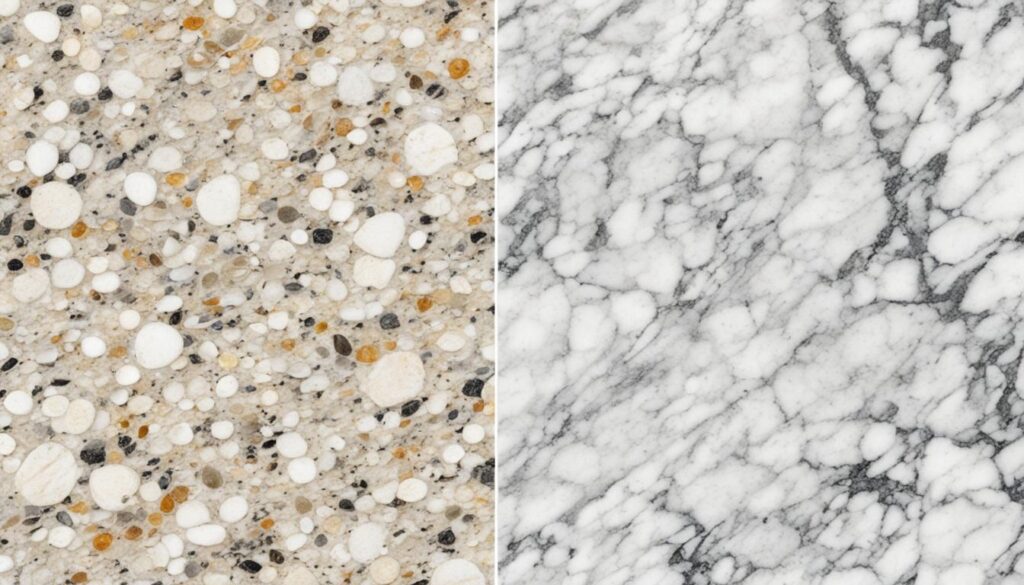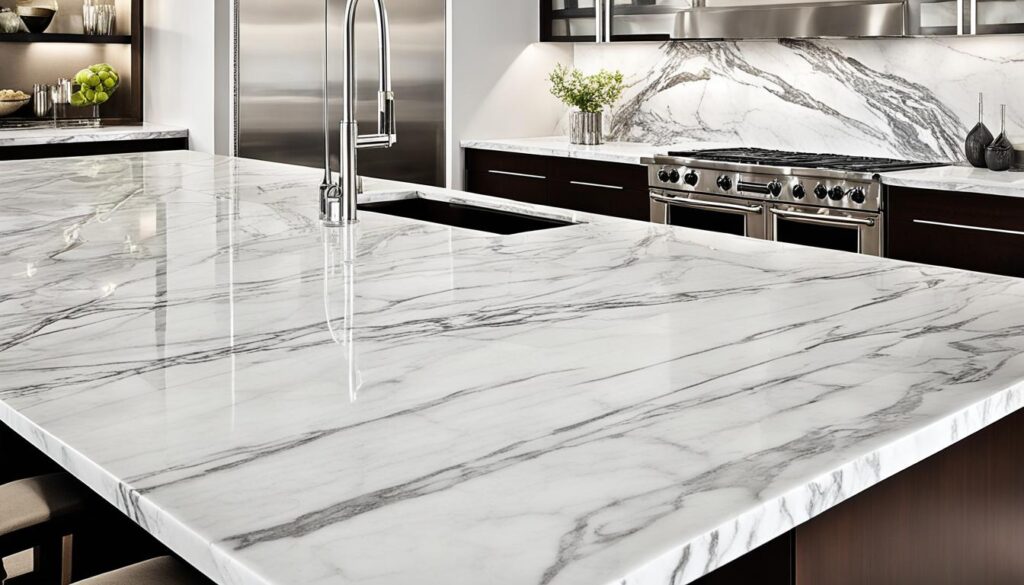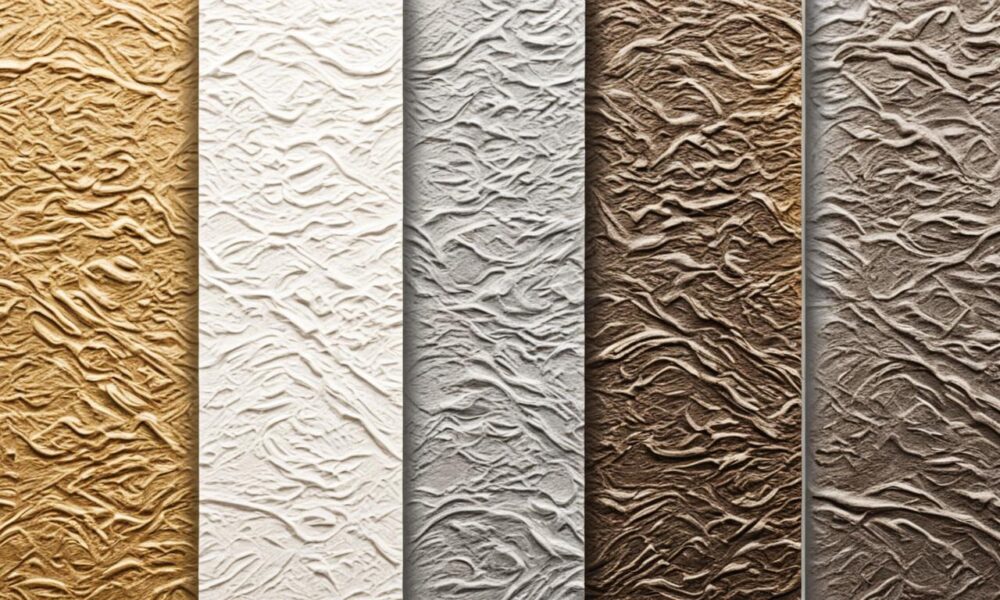Marble vs. Granite: Best Stone for Countertops
Embarking on a kitchen renovation often involves a pivotal decision—choosing the perfect countertop material. Pacing the floors of stone suppliers, homeowners meticulously agonize over the countertop comparison of two esteemed giants: marble and granite. These natural stone countertops are at the heart of the debate, each promising to transform the kitchen into a hub of elegance and function. Granite countertops, with their diverse palette and robust durability, are revered as one of the best countertops for those leading a bustling kitchen life. On the flip side, marble countertops whisper tales of grandeur and luxe, yet whisper cautionary tales of their sensitivity to life’s spills and mishaps. Whether it’s a humble refresh or a grand kitchen overhaul, navigating the nuances of marble and granite ensures a countertop choice that doesn’t just fit the bill but also elevates the heart of the home.
Key Takeaways
- Both marble and granite countertops bring unique aesthetics and resilience to the table.
- Granite offers extensive color variations and a reputation for durability.
- Marble stands out for its classic elegance but requires more careful maintenance.
- Heat resistance is a shared advantage, making both stones fitting for kitchens.
- Deciding between marble vs. granite is a balance of beauty, budget, and upkeep.
- Granite tends to be the pragmatic choice for high-traffic kitchens.
- Understanding each stone’s characteristics is crucial for a successful kitchen renovation.
Understanding the Basics of Marble and Granite
When it comes to natural stone countertops, marble and granite stand out as premium choices that blend durability with natural beauty, making them perennial favorites in the realm of countertop materials. Each of these stones has its own unique genesis deep within the Earth, resulting in their distinctive patterns, colors, and qualities. Unraveling the intricacies of these two materials is invaluable for homeowners engaged in countertop selection for their renovation projects.
Formation and Composition of Marble
Marble’s luxurious sheen is the product of metamorphosis – a transformation that begins with limestone exposed to intense pressure and temperatures within the Earth’s crust. Composed mainly of recrystallized carbonate minerals, marble is noted for its signature veining and comes in a spectrum ranging from stark white to rich blacks, and occasionally in captivating shades like blues, pinks, and creams. This versatile stone has a legacy of being associated with grandeur, making it an esteemed choice within the pantheon of stone countertop options.
Formation and Composition of Granite
In contrast, granite owes its existence to the cooling and solidifying of magma beneath the Earth’s surface. Characterized as an igneous rock, it comprises a sturdy blend of minerals, including quartz, feldspar, mica, and others. It offers a typically granular appearance and a spectrum of colors that contribute to its granitic pattern. Formed under different processes, granite emerges as a multi-hued canvas with a hardy character, suited to withstand the rigors of a bustling kitchen.
Despite their distinctive traits, both marble and granite share a competency for melding aesthetics and robustness. As homeowners canvas through various countertop materials, understanding these natural formations sheds light on the harmony between the geological artistry and the practical demands of today’s kitchens – a key part of the countertop selection process. Both materials offer an array of stone countertop options, ensuring there’s a match for nearly every style and function.
- Natural Stone Countertops: A blend of style and durability
- Countertop Materials: Reflecting individual aesthetics and functionality
- Countertop Selection: Decisions influenced by unique stone characteristics
- Stone Countertop Options: A spectrum of colors and patterns
Marble vs. Granite: Which Natural Stone Is Best for Your Countertops?
Selecting the best countertops for a kitchen can be an intricate task, as it demands blending aesthetics with functionality. The countertop comparison often boils down to two main contenders: marble and granite. These natural stone countertops offer distinct advantages and carry certain constraints that grip the attention of homeowners and designers alike. In exploring the highs and lows of marble and granite, this section delves into their individual traits to help determine which may be the ideal choice for your culinary space.

Pros and Cons of Marble Countertops
Marble, with its elegant vein patterns and a color palette ranging from pristine whites to dramatic blacks, often takes the center stage in any setting it graces. Its opulent appearance and unique patterns have long made marble a symbol of sophistication in home décor. However, the very features that make marble countertops alluring also contribute to their delicacy. Due to its porous nature, marble can succumb to staining and scratches more readily than granite, necessitating a regimen of constant care and maintenance.
Pros and Cons of Granite Countertops
Granite stands as a paragon of durability and ease of maintenance amongst countertop materials. Known for its extensive color variations and enduring surface, granite resists heat commendably and is less likely to face harm from everyday kitchen activities. The natural stone’s vigor makes it a popular choice for those who prize longevity and practicality alongside beauty. Notwithstanding its robustness, granite does possess some variability, as its myriad hues and patterns differ from slab to slab, which might influence both aesthetics and performance.
| Feature | Marble | Granite |
|---|---|---|
| Visual Appeal | Elegant veining, wide color selection | Diverse colors, natural granular patterns |
| Durability | More susceptible to scratching and staining | Highly durable, enduring scratch and stain resistance |
| Maintenance | Requires regular sealing and swift spill clean-ups | Lower maintenance, with periodic sealing recommended |
| Heat Resistance | High – with proper sealing | High – typically heat-resistant |
| Cost | Generally more expensive | More budget-friendly options available |
Marble and granite carry their own cachet and set of challenges in the realm of kitchen renovations. While marble can infuse an ambience with luxury, the commitment to its preservation cannot be understated. Granite, conversely, provides a harmonious balance between functionality and natural beauty, making it one of the best countertops for those prioritizing durability. Whether swayed by the majestic allure of marble or the resilient nature of granite, selecting the right material lays the foundation for a kitchen that’s as practical as it is aesthetically pleasing.
Aesthetic Differences: Appearance and Style
The lustrous charm and nuanced style of countertop materials play a pivotal role in the aesthetics of a kitchen renovation. In the quest for the perfect natural stone countertops, marble and granite emerge as frontrunners, each boasting a unique allure. Marble, celebrated for its ethereal and timeless beauty, features a consistent color span coupled with extraordinary veining that ensures the originality of each slab. These intricate and serpentine veins, born from the presence of mineral impurities such as iron oxide, add to marble’s reputation for opulence and luxury.

Contrasting this sophistication, granite proposes a more primal and earthy aesthetic. It parades a diverse and rich chromatic range — a kaleidoscope of colors gifted by its composite minerals like silica, mica, feldspar, and quartz. This vibrant coloration is juxtaposed with the rugged, granular textures that are the hallmark of granite’s intrinsic beauty. Thus, the choice between the refined elegance of marble and the untamed allure of granite ultimately hinges on individual taste and the stylistic statement one wishes to make in their culinary domain.
Though divergent in their appeal, both marble and granite countertops serve as embodiments of nature’s artistry, enriching the kitchen renovation process with their distinctive style. Let us discern these differences with a closer look:
| Attribute | Marble | Granite |
|---|---|---|
| Primary Appeal | Elegance through veining | Rugged, natural looks |
| Color Range | From pristine whites to deep blacks and colorful hues | Expansive spectrum, including earth tones and vivid shades |
| Texture | Smooth with delicate veins | Grainy with mineral flecks |
| Pattern Uniqueness | Each slab is a unique artwork | Varied patterns, no two slabs are the same |
| Ideal Use | Luxury spaces, focal points | High-traffic areas, practical applications |
Whether drawn to the classical grace of marble or the unspoiled essence of granite, homeowners are spoilt for choice. Each stone type infuses the kitchen with a distinctive personality, making the selection a testament to personal style and the envisioned ambiance for one’s culinary retreat. Embrace the journey of discovering which of these stunning countertop materials aligns with your envisioned kitchen renovation aesthetic, ensuring a result that resonates with your unique lifestyle and taste.
Practical Considerations: Maintenance and Durability
When considering the longevity of natural stone countertops, understanding the nuances of countertop maintenance for different materials is crucial. Whether you opt for the soft elegance of marble or the hard-wearing nature of granite, both require specific care to preserve their beauty and functionality over time. Here we’ll explore the maintenance regimes and durability concerns associated with both marble and granite countertops, the twin titans of countertop materials.
Caring for Marble Countertops
Marble’s luxurious appearance belies its susceptibility to the rigors of daily kitchen use. As a naturally porous material, marble countertops demand meticulous sealing to combat their inclination to absorb liquids, leading to potential staining and etching. Acids can be particularly nefarious, often leaving marks that are challenging to remove. To maintain the pristine condition of marble, immediate clean-up of spills is advised, along with the use of cutting boards and coasters to prevent scratches and damage.
Caring for Granite Countertops
Renowned for its rugged resilience, granite requires a less intensive maintenance schedule. Although granite countertops are not invulnerable to the passage of time and use, they generally resist scratches and chips more effectively than their marble counterparts. Nonetheless, regular sealing is recommended to ensure ongoing protection against staining, keeping the natural stone’s appearance immune to daily exposures. The inherent strength of granite rewards owners with a forgiving surface that stands up admirably to the demands of busy kitchens and high traffic areas.
While both marble and granite countertops exude elegance and strength, they do so on divergent paths of maintenance and care. Homeowners should weigh not only the countertop materials‘ visual and tactile appeal but also the practical implications of their routine upkeep. Below is a helpful table summarizing key maintenance and durability aspects:
| Countertop Material | Main Care Considerations | Durability Features | Recommended Maintenance Frequency |
|---|---|---|---|
| Marble | Sealing, immediate clean-up of spills, use of protective accessories | Prone to scratching/staining; can last with care | Sealing every 6-12 months; daily attention to spills and stains |
| Granite | Periodic sealing, regular cleaning with mild detergent | Resists scratching/chipping; handles high-trafficked areas well | Sealing every 1-2 years; routine cleaning |
In conclusion, countertop maintenance is an indispensable part of preserving the lifespan and beauty of your kitchen or bathroom surfaces. Whether you choose marble or granite, each material’s needs must be understood and tended to with regular care, ensuring your natural stone countertops remain a central showpiece of your home for years to come.
Installation Process for Stone Countertops
The journey of elevating your kitchen space with natural stone countertops culminates in a critical phase: the countertop installation. This process, pivotal in your kitchen renovation, is not just about placing a slab atop cabinets. It’s a choreographed sequence that brings together artisanal skill, precision engineering, and an understanding of the materials’ inherent properties.
For both granite and marble countertops, the journey from quarry to kitchen is intricate, demanding the hands of seasoned professionals. The process kicks off with creating an accurate template of the kitchen’s counter space, reflecting every nook and curve to ensure the eventual stone cutting is executed with absolute precision.
This template guides the cutting of your chosen slab—be it the veined elegance of marble or the mottled depth of granite—transforming rough stone into sleek counters. Each cut must accommodate the unique dimensions and fixtures of your kitchen, from sinks to cooktops, a task requiring the steadiest of hands and keenest of eyes.
Once cut to perfection, the slabs are gently laid into place, usually directly onto cabinet surfaces or a sturdy plywood base. A high-quality silicone adhesive then anchors your stone securely, ensuring a lasting fit. The enduring bond formed is a quiet testament to the strength and quality that natural stone brings to your home.
Detail doesn’t end at placement. Holes and grooves for sinks, faucets, and other fittings are meticulously carved into the stone. This step highlights the stony toughness of both granite and marble, demanding specialized tools and techniques only possessed by skilled countertop installers.
The installation narrative of your countertop materials thus weaves together art and expertise, yielding not merely a work surface, but a centerpiece for family life and culinary adventure—a lasting imprint of your kitchen’s transformation. Trusting this task to professionals ensures that the beauty and integrity of your granite or marble countertops are not only preserved but also highlighted, sealing the bond between tradition and modernity in your renovation story.
Cost Analysis: Comparing Prices of Marble and Granite
When it comes to selecting countertops for your kitchen, understanding the cost comparison between marble and granite is essential. These two natural stone countertops not only differ in their aesthetic appeal and durability but also in their impact on your renovation budget. Below, we explore the nuances of countertop prices to aid you in making an informed decision between the splendor of marble and the pragmatic charm of granite.
Affordability of Marble
Pursuing the timeless elegance of marble for your countertops comes at a price. With marble vs. granite standing out as a premium option, marble countertops can introduce a higher degree of sophistication at a starting cost of about $100 per square foot installed. Depending on the rarity of the marble, intricacy of the design, and market demand, prices can soar beyond $200 per square foot for luxe, custom installations.
Value Proposition of Granite
In the spectrum of affordable countertops, granite presents a more cost-effective solution while still offering the beauty and resilience associated with natural stone countertops. Starting at an approximate price of $75 per square foot installed, granite countertops can increase in price with the selection of exotic colors or unique veining. Nonetheless, they remain a popular choice for their balance of cost efficiency and aesthetic flexibility.
| Countertop Material | Starting Cost | Cost Influencing Factors | Potential Cost Range |
|---|---|---|---|
| Marble | $100/sq ft | Design complexity, rarity | $100-$200+/sq ft |
| Granite | $75/sq ft | Color rarity, pattern uniqueness | $75-$175+/sq ft |
To navigate the landscape of countertop prices, it’s advisable to obtain multiple estimates, considering not only the square footage but also the job’s complexity. This includes the number of seams, edging style, and sink cutouts required. These estimates will provide a clearer picture of the overall investment and help homeowners balance their desires for natural stone countertops with the realities of their renovation budget.
Conclusion
In the landscape of kitchen renovation, the quest for the best countertops often narrows down to a choice between two esteemed countertop materials: marble and granite. These natural stone countertops emerge not only as crowning pieces to one’s culinary precinct but also as reflections of homeowners’ tastes and lifestyles. Marble, with its regal aura, caters to those desiring a dash of classic elegance and is often selected for its unmatched, sophisticated beauty. Granite, celebrated for its intricate natural patina, offers a practical and robust option suitable for kitchens that buzz with activity.
Final Recommendations for Countertop Selection
When it’s time for countertop selection, the homeowner’s personal aesthetic, the expected kitchen activity levels, and the readiness for upkeep must guide the decision-making process. Those willing to embrace the elegance and upkeep of marble will find it unparalleled in its classical beauty. Conversely, for those prioritizing longevity and a forgiving maintenance schedule, granite provides a compelling and cost-effective solution. It is the alignment of these elements that will ensure the chosen countertop materials not only complement the kitchen’s design but also fulfill functional expectations.
Maximizing Investment in Natural Stone Countertops
In essence, maximizing the investment in natural stone countertops is a balance act—one that considers the enduring qualities of both marble and granite against practicality and budget. A mindful homeowner will weigh the illustrious charm of marble against its fragility and the steadfastness of granite against its occasional monotony. The final criterion hinges on which material’s quality can withstand the test of time in both form and function. Therefore, careful deliberation is paramount to ensure that the selection not only meets the immediate allure of a kitchen renovation but also pledges a timeless contribution to the home’s value and utility.



